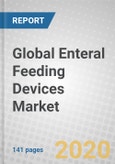Report Scope:
The global enteral feeding devices market generally consists of enteral feeding pumps, oroenteric tubes, cardiac monitors, nasoenteric tubes (sub-segmented into nasojejunal, nasoduodenal and nasogastric tube), gastrostomy tubes (sub-segmented into percutaneous endoscopic gastrostomy devices and low-profile gastrostomy device) and jejunostomy tubes (sub-segmented into percutaneous endoscopic jejunostomy and percutaneous radiological jejunostomy tubes). This report does not include other medical devices used in hospitals.
The scope of the report includes an overview of the global market for enteral feeding devices and analyses of global market trends, using 2019 as the base year and forecasting 2020 through 2025 with compound annual growth rate (CAGR) projections.
The report discusses technological, application, regulatory and economic trends that impact the market. It also explains the major drivers and regional dynamics of the global market and current trends within the industry.
Enteral feeding devices end users are categorized into hospitals, homecare settings and ambulatory surgical centers. Regional analysis includes North America (U.S., Canada), Europe (U.K., Germany, France, Spain, Italy, Rest of Europe), Asia-Pacific (China, India, Japan and Rest of Asia-Pacific), South America, and the Middle East and Africa.
The report concludes with detailed profiles of the major vendors in the global enteral feeding devices market.
The Report Includes:
The global enteral feeding devices market generally consists of enteral feeding pumps, oroenteric tubes, cardiac monitors, nasoenteric tubes (sub-segmented into nasojejunal, nasoduodenal and nasogastric tube), gastrostomy tubes (sub-segmented into percutaneous endoscopic gastrostomy devices and low-profile gastrostomy device) and jejunostomy tubes (sub-segmented into percutaneous endoscopic jejunostomy and percutaneous radiological jejunostomy tubes). This report does not include other medical devices used in hospitals.
The scope of the report includes an overview of the global market for enteral feeding devices and analyses of global market trends, using 2019 as the base year and forecasting 2020 through 2025 with compound annual growth rate (CAGR) projections.
The report discusses technological, application, regulatory and economic trends that impact the market. It also explains the major drivers and regional dynamics of the global market and current trends within the industry.
Enteral feeding devices end users are categorized into hospitals, homecare settings and ambulatory surgical centers. Regional analysis includes North America (U.S., Canada), Europe (U.K., Germany, France, Spain, Italy, Rest of Europe), Asia-Pacific (China, India, Japan and Rest of Asia-Pacific), South America, and the Middle East and Africa.
The report concludes with detailed profiles of the major vendors in the global enteral feeding devices market.
The Report Includes:
- 24 data tables and 19 additional tables
- An overview of the global enteral feeding devices market
- Analyses of the global market trends, with corresponding market analysis data for 2019, estimates for 2020, and projections of compound annual growth rates (CAGRs) through 2025
- Highlights of current and future market potential for various equipment used in enteral feeding devices, as well as its product segments and key market developments
- Estimation of the market size and market forecast for enteral feeding devices, with detailed market share analysis on the basis of product types and their subsegments, end users, application areas, and major geographical regions
- Country specific data and market value analysis for the U.S., Canada, Mexico, Germany, U.K., France, Italy, Spain, Japan, China, India, and other emerging economies
- Insights into the current market trends, opportunities and restraints, regulatory framework, and industry value chain analysis of the enteral feeding market
- Impact of COVID-19 pandemic on enteral feeding medical devices and product sub-segments
- Regulatory structures and parameters required for approval or clearance of enteral feeding medical devices in some key countries
- Profile descriptions of the leading market participants, including Abbott, Fresenius Kabi AG, Boston Scientific Corp., Medtronic (Covidien), Nestlé S.A. and Groupe Danone
Table of Contents
Chapter 1 Introduction
Chapter 3 Market and Technology Background
Chapter 4 Medical Dynamics
Chapter 5 COVID-19’s Impact on the Enteral Feeding Devices Market
Chapter 6 Market Breakdown by Product Type
Chapter 7 Market Breakdown by Region
Chapter 8 Market Breakdown by End User
Chapter 9 Market Breakdown by Application
Chapter 10 Regulatory Structure
Chapter 11 Company Profiles
List of Tables
List of Figures
Executive Summary
Increased pre-term birth rates, aging population growth, increased prevalence of chronic diseases such as diabetes, cancer, GI and neurological disorders, and increased awareness of enteral nutrition, as well as rapid healthcare progress in emerging countries, are expected to drive the market, as is the increasing need for enteral feeding devices such as feeding tubes and administration sets for COVID-19 care. However, the market is restrained due to factors such as high competitiveness and pricing pressure.
Companies Mentioned
- Abbott
- B. Braun Melsungen Ag
- Becton, Dickinson And Co.
- Boston Scientific Corp.
- Conmed
- Fresenius Kabi Ag
- Groupe Danone
- Medtronic (Covidien)
- Nestle S.A.








